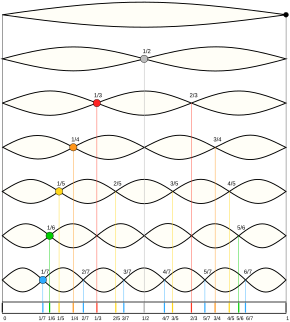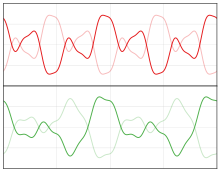Musical acoustics
Musical acousticsormusic acousticsis a multidisciplinary field that combines knowledge fromphysics,[1][2][3]psychophysics,[4]organology[5](classification of the instruments),physiology,[6]music theory,[7]ethnomusicology,[8]signal processingand instrument building,[9]among other disciplines. As a branch ofacoustics,it is concerned with researching and describing the physics ofmusic– howsoundsare employed to make music. Examples of areas of study are the function ofmusical instruments,thehuman voice(the physics ofspeechandsinging), computer analysis ofmelody,and in the clinical use of music inmusic therapy.
The pioneer of music acoustics wasHermann von Helmholtz,a German polymath of the 19th century who was an influentialphysician,physicist,physiologist, musician, mathematician and philosopher. His bookOn the Sensations of Tone as a Physiological Basis for the Theory of Music[7]is a revolutionary compendium of several studies and approaches that provided a complete new perspective tomusic theory,musical performance,music psychologyand the physical behaviour of musical instruments.
Methods and fields of study[edit]
- Thephysicsofmusical instruments
- Frequency range of music
- Fourier analysis
- Computeranalysisof musical structure
- Synthesisof musical sounds
- Music cognition,based on physics (also known aspsychoacoustics)
Physical aspects[edit]

Whenever two different pitches are played at the same time, their sound waves interact with each other – the highs and lows in the air pressure reinforce each other to produce a different sound wave. Any repeating sound wave that is not a sine wave can be modeled by many different sine waves of the appropriate frequencies and amplitudes (afrequency spectrum). Inhumansthehearingapparatus (composed of theearsandbrain) can usually isolate these tones and hear them distinctly. When two or more tones are played at once, a variation of air pressure at the ear "contains" the pitches of each, and the ear and/or brain isolate and decode them into distinct tones.
When the original sound sources are perfectly periodic, thenoteconsists of several related sine waves (which mathematically add to each other) called thefundamentaland theharmonics,partials,orovertones.The sounds haveharmonicfrequency spectra.The lowest frequency present is the fundamental, and is the frequency at which the entire wave vibrates. The overtones vibrate faster than the fundamental, but must vibrate at integer multiples of the fundamental frequency for the total wave to be exactly the same each cycle. Real instruments are close to periodic, but the frequencies of the overtones are slightly imperfect, so the shape of the wave changes slightly over time.[citation needed]
Subjective aspects[edit]
Variations inairpressureagainst theeardrum, and the subsequent physical and neurological processing and interpretation, give rise to the subjective experience calledsound.Most sound that people recognize asmusicalis dominated byperiodicor regular vibrations rather than non-periodic ones; that is, musical sounds typically have adefinite pitch.The transmission of these variations through air is via a soundwave.In a very simple case, the sound of asine wave,which is considered the most basic model of a sound waveform, causes the air pressure to increase and decrease in a regular fashion, and is heard as a very pure tone. Pure tones can be produced bytuning forksorwhistling.The rate at which the air pressure oscillates is thefrequencyof the tone, which is measured in oscillations per second, calledhertz.Frequency is the primary determinant of the perceivedpitch.Frequency of musical instruments can change with altitude due to changes in air pressure.
Pitch ranges of musical instruments[edit]

*This chart only displays down to C0,though some pipe organs, such as theBoardwalk Hall Auditorium Organ,extend down to C−1(one octave below C0). Also, the fundamental frequency of thesubcontrabass tubais B♭−1.
Harmonics, partials, and overtones[edit]

Thefundamentalis the frequency at which the entire wave vibrates. Overtones are other sinusoidal components present at frequencies above the fundamental. All of the frequency components that make up the total waveform, including the fundamental and the overtones, are calledpartials.Together they form theharmonic series.
Overtones that are perfect integer multiples of the fundamental are calledharmonics.When an overtone is near to being harmonic, but not exact, it is sometimes called a harmonic partial, although they are often referred to simply as harmonics. Sometimes overtones are created that are not anywhere near a harmonic, and are just called partials or inharmonic overtones.
The fundamental frequency is considered thefirst harmonicand thefirst partial.The numbering of the partials and harmonics is then usually the same; the second partial is the second harmonic, etc. But if there are inharmonic partials, the numbering no longer coincides. Overtones are numbered as they appearabovethe fundamental. So strictly speaking, thefirstovertone is thesecondpartial (and usually thesecondharmonic). As this can result in confusion, only harmonics are usually referred to by their numbers, and overtones and partials are described by their relationships to those harmonics.
Harmonics and non-linearities[edit]

When a periodic wave is composed of a fundamental and only odd harmonics (f,3 f,5 f,7 f,...), the summed wave ishalf-wavesymmetric;it can be inverted and phase shifted and be exactly the same. If the wave has any even harmonics (2 f,4 f,6 f,...), it isasymmetrical;the top half of the plotted wave form does not mirror image the bottom.
Conversely, a system that changes the shape of the wave (beyond simple scaling or shifting) creates additional harmonics (harmonic distortion). This is called anon-linearsystem.If it affects the wave symmetrically, the harmonics produced are all odd. If it affects the harmonics asymmetrically, at least one even harmonic is produced (and probably also odd harmonics).
Harmony[edit]
If two notes are simultaneously played, with frequencyratiosthat are simple fractions (e.g. 2 / 1 ,3/ 2 ,or5/ 4 ), the composite wave is still periodic, with a short period – and the combination soundsconsonant.For instance, a note vibrating at 200Hzand a note vibrating at 300 Hz (aperfect fifth,or3/ 2 ratio,above 200 Hz) add together to make a wave that repeats at 100 Hz: Every1/ 100 of a second, the 300 Hz wave repeats three times and the 200 Hz wave repeats twice. Note that thecombinedwave repeats at 100 Hz, even though there is no actual 100 Hz sinusoidal component contributed by an individual sound source.
Additionally, the two notes from acoustical instruments will have overtone partials that will include many that share the same frequency. For instance, a note with the frequency of its fundamental harmonic at 200Hzcan have harmonic overtones at: 400, 600, 800,1000,1200,1400,1600,1800,...Hz. A note with fundamental frequency of 300 Hz can have overtones at: 600, 900,1200,1500,1800,...Hz. The two notes share harmonics at 600,1200,1800Hz,and more that coincide with each other, further along in the each series.
Although the mechanism of human hearing that accomplishes it is still incompletely understood, practical musical observations for nearly2000years[10]The combination of composite waves with short fundamental frequencies and shared or closely related partials is what causes the sensation of harmony: When two frequencies are near to a simple fraction, but not exact, the composite wave cycles slowly enough to hear the cancellation of the waves as a steady pulsing instead of a tone. This is calledbeating,and is considered unpleasant, ordissonant.
The frequency of beating is calculated as the difference between the frequencies of the two notes. When two notes are close in pitch they beat slowly enough that a human can measure the frequencydifferenceby ear, with astopwatch;beat timing is how tuning pianos, harps, andharpsichordsto complicatedtemperamentswas managed before affordabletuning meters.
- For the example above,|200Hz− 300Hz| = 100Hz.
- As another example frommodulationtheory, a combination of 3425Hz and 3426Hz would beat once per second, since |3425Hz−3426Hz| = 1Hz.
The difference between consonance and dissonance is not clearly defined, but the higher the beat frequency, the more likely the interval is dissonant.Helmholtzproposed that maximum dissonance would arise between two pure tones when the beat rate is roughly 35 Hz.[11]
Scales[edit]
The material of a musical composition is usually taken from a collection of pitches known as ascale.Because most people cannot adequately determineabsolutefrequencies, the identity of a scale lies in the ratios of frequencies between its tones (known asintervals).
Thediatonic scaleappears in writing throughout history, consisting of seven tones in eachoctave.Injust intonationthe diatonic scale may be easily constructed using the three simplest intervals within the octave, theperfect fifth(3/2),perfect fourth(4/3), and themajor third(5/4). As forms of the fifth and third are naturally present in theovertone seriesof harmonic resonators, this is a very simple process.
The following table shows the ratios between the frequencies of all the notes of the justmajor scaleand the fixed frequency of the first note of the scale.
| C | D | E | F | G | A | B | C |
|---|---|---|---|---|---|---|---|
| 1 | 9/8 | 5/4 | 4/3 | 3/2 | 5/3 | 15/8 | 2 |
There are other scales available through just intonation, for example theminor scale.Scales that do not adhere to just intonation, and instead have their intervals adjusted to meet other needs are calledtemperaments,of whichequal temperamentis the most used. Temperaments, though they obscure the acoustical purity of just intervals, often have desirable properties, such as a closedcircle of fifths.
See also[edit]
- Acoustic resonance
- Cymatics
- Mathematics of musical scales
- String resonance
- Vibrating string
- 3rd bridge(harmonic resonance based on equal string divisions)
- Basic physics of the violin
References[edit]
- ^Benade, Arthur H.(1990).Fundamentals of Musical Acoustics.Dover Publications.ISBN9780486264844.
- ^Fletcher, Neville H.; Rossing, Thomas (2008-05-23).The Physics of Musical Instruments.Springer Science & Business Media.ISBN9780387983745.
- ^Campbell, Murray; Greated, Clive (1994-04-28).The Musician's Guide to Acoustics.OUP Oxford.ISBN9780191591679.
- ^Roederer, Juan (2009).The Physics and Psychophysics of Music: An Introduction(4 ed.). New York: Springer-Verlag.ISBN9780387094700.
- ^Henrique, Luís L. (2002).Acústica musical(in Portuguese). Fundação Calouste Gulbenkian.ISBN9789723109870.
- ^Watson, Lanham, Alan H. D., ML (2009).The Biology of Musical Performance and Performance-Related Injury.Cambridge: Scarecrow Press.ISBN9780810863590.
{{cite book}}:CS1 maint: multiple names: authors list (link) - ^abHelmholtz, Hermann L. F.; Ellis, Alexander J. (1885).On the Sensations of Tone as a Physiological Basis for the Theory of Music by Hermann L. F. Helmholtz.doi:10.1017/CBO9780511701801.hdl:2027/mdp.39015000592603.ISBN9781108001779.Retrieved2019-11-04.
{{cite book}}:|website=ignored (help) - ^Kartomi, Margareth (1990).On Concepts and Classifications of Musical Instruments.Chicago: University of Chicago Press.ISBN9780226425498.
- ^Hopkin, Bart (1996).Musical Instrument Design: Practical Information for Instrument Design.See Sharp Press.ISBN978-1884365089.
- ^Ptolemy, Gaius Claudius.HarmonikonἉρμονικόν[Harmonics]. yearc. 180CE.
- ^"Roughness".music-cog.ohio-state.edu(course notes). Music 829B.Ohio State University.
External links[edit]
- Music acoustics - sound files, animations and illustrations - University of New South Wales
- Acoustics collection - descriptions, photos, and video clips of the apparatus for research in musical acoustics by Prof.Dayton Miller
- The Technical Committee on Musical Acoustics (TCMU) of the Acoustical Society of America (ASA)
- The Musical Acoustics Research Library (MARL)
- Acoustics Group/Acoustics and Music Technology courses - University of Edinburgh
- Acoustics Research Group - Open University
- The music acoustics group at Speech, Music and Hearing KTH
- The physics of harpsichord sound
- Visual music
- Savart Journal - The open access online journal of science and technology of stringed musical instruments
- Interference and ConsonancefromPhysclips
- Curso de Acústica Musical(Spanish)

